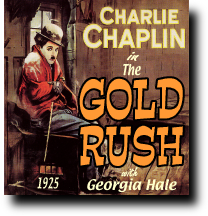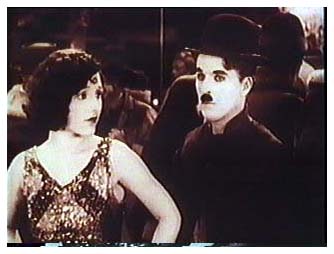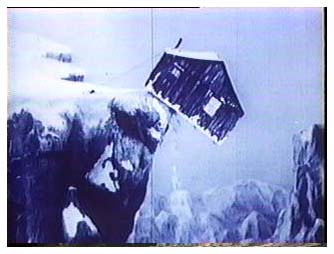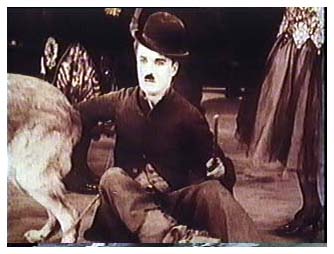

United Artists
Cast: Charlie Chaplin (the tramp), Georgia Hale (Georgia), Mack Swain (Big Jim McKay), Tom Murray (Black Larsen), Henry Bergman (Hank Curtis)
After finding a "mountain of gold" and staking
out his claim during the 1898 Yukon gold rush, Big Jim McKay finds
himself seeking refuge in a dilapidated, abandoned shack with
fugitive Black  Larsen and the little
tramp. After days of hunger, the storm continues, and the men
realize they must do something or starve. By cutting cards, it
is decided Larsen will go for food. After venturing out, Larsen
happens upon two law enforcement officers, kills them and steals
their supplies. He does not return to the cabin. Meanwhile, the
tramp and Big Jim kill a bear which provides them the food they
need until the storm subsides.
Larsen and the little
tramp. After days of hunger, the storm continues, and the men
realize they must do something or starve. By cutting cards, it
is decided Larsen will go for food. After venturing out, Larsen
happens upon two law enforcement officers, kills them and steals
their supplies. He does not return to the cabin. Meanwhile, the
tramp and Big Jim kill a bear which provides them the food they
need until the storm subsides.
They leave the cabin and part company. Big Jim goes back to his claim and finds Larsen there. In a fight. Larsen hits Big Jim over the head with a shovel knocking him out. Later, Larsen meets his end as the snow under him gives way on a steep precipice.
The tramp arrives in town and visits the dance hall. There he meets and falls in love with Georgia, a beautiful dance hall girl, which also brings down the wrath of ladies' man Jack Cameron who considers Georgia his girl.
The tramp later makes friends with Hank Curtis who lets the little fellow stay in his cabin while he goes to check on his claim. One day, Georgia and the other dance hall girls happen upon the cabin, and the tramp invites them for a New Year's Eve dinner. As a joke, they accept the invitation.
The tramp works shoveling snow in the town so he can afford the meal and gifts for the girls. On New Year's Eve, he has the food cooked, the table set, and the gifts wrapped, but Georgia and the others do not show up. They are busying celebrating at the dance hall with no thought of the tramp.
Finally, after midnight, Georgia suggests to Jack and the
girls that they go to the tramp's cabin and "have some fun"
with him. When they arrive, he is not there. He has gone to the
dance hall to see where Georgia is. When Georgia sees the table
and what has been prepared, she begins to feel remorse and tells
the others "the joke has gone too far."
Later, Big Jim wanders into town in a dazed state. He goes to
the recorder's office to record his claim, but can't remember
where the claim as a result of the blow to his head. He realizes
that he can find the claim again if he can only locate the little
cabin that he, the tramp and Larsen stayed in.
 In the dance hall, Georgia has
written a love note to Jack, but she is hurt and angered when
she sees him make light of it and pass it around carelessly for
others at his table to see. When the tramp comes in, Jack has
the note delivered to him, and the tramp really believes Georgia
wrote it to him. Before he can get to Georgia, Big Jim comes in
the dance hall and recognizes the tramp. He knows the tramp can
show him where the cabin is which will lead him back to his claim.
He tells the tramp he will split his fortune with him if he will
guide him back to the cabin, and Big Jim drags the tramp off.
In the dance hall, Georgia has
written a love note to Jack, but she is hurt and angered when
she sees him make light of it and pass it around carelessly for
others at his table to see. When the tramp comes in, Jack has
the note delivered to him, and the tramp really believes Georgia
wrote it to him. Before he can get to Georgia, Big Jim comes in
the dance hall and recognizes the tramp. He knows the tramp can
show him where the cabin is which will lead him back to his claim.
He tells the tramp he will split his fortune with him if he will
guide him back to the cabin, and Big Jim drags the tramp off.
After weathering a stormy night in the cabin which almost blows it off a precipice, with Big Jim and the tramp in it, they find the claim. When next we see them, the two are on a steamer, wealthy millionaires, headed for home. By coincidence, Georgia is on the steamer, too, and she and the tramp reunite with plans to marry.
Certainly there are people who prefer "City Lights" or "The Kid" or "Modern Times," but, if a poll were taken, it would be safe to say that "The Gold Rush" would emerge as the favorite Charlie Chaplin film for most silent movie buffs. And, quite often, it emerges as the favorite of all silent films for some, and deservedly so.
Chaplin's forte has always been the ability to combine comedy and pathos, and ever since "The Tramp" (1915), he exhibited an ever increasing skill at this delicate balancing act. "The Gold Rush" may not have been Chaplin's most successful matching of the two (many would say "City Lights" deserves this honor), but it is a masterful blending so that one does not overwhelm the other, and the comedy plays off the pathos, and vice versa, without being forced or inappropriate. Considering the backdrop for this story, Chaplin deserves some extra creditfor this balancing act, for the struggles and hardships endured during the 1898 gold rush could prove to be too delicate a subject for comedy (consider the presence of death and near starvation in the storyline), but he handles them adroitly and without offending the senses.
 Also, if asked to name the most
famous sequence or sequences in a Chaplin film, the Dance of the
Rolls and the eating of the cooked boot come to mind immediately,
both from "The Gold Rush" (the ending to "City
Lights" is also right up there with the most memorable).
These are indelibly etched in our memories and are a part of the
Chaplin lore as well as silent movie lore in general.
Also, if asked to name the most
famous sequence or sequences in a Chaplin film, the Dance of the
Rolls and the eating of the cooked boot come to mind immediately,
both from "The Gold Rush" (the ending to "City
Lights" is also right up there with the most memorable).
These are indelibly etched in our memories and are a part of the
Chaplin lore as well as silent movie lore in general.
The film is sprinkled throughout with bits and pieces of
genius, and, yes, there is slapstick, but it's slapstick with
a reason, not just for slapstick's sake. Here are some examples:
. . . Big Jim and Black Larsen struggle to wrest the rifle from
one another. As the two fight over the weapon, the tramp scurries
all around the little cabin trying to move from in front of the
gun barrel. However, no matter where he moves - under the table,
stranding on the bed - the gun barrel follows him aimed straight
for him.
. . . Lacking one shoe, the tramp has one of his feet wrapped
rather bulkily with burlap or some similar material to keep it
warm. While filling a lamp with kerosene, he spills some of the
fuel on the wrapped foot. When Georgia and the other girls are
visiting him in the cabin, one of the girls throw a lighted match
down which lands on his foot. The kerosene ignites. At first no
one realizes this as he has his legs crossed and the foot is under
the chair of one of the girls. Soon, however, the chair catches
fire, the girl jumps up, and the tramp hurriedly extinguishes
his burning foot.
. . . In his first meeting with Georgia in the dance hall, the
tramp has an opportunity to dance with her, however, he is having
a hard time keeping his pants up and tries to hide this from Georgia.
He spies a piece of rope on a table, and, while Georgia turns
to speak to someone, he quickly ties it around his waist. When
they go on dancing, it becomes obvious that rope is attached to
a dog. This is not a problem until the dog notices a cat and chases
after it, dragging the tramp behind him.
All of this are delightful bits of business that add to the charm of the film, keep it moving along at a nice pace and prevent the serious side of the film from burying the comedy.
There have been some comments over the years about Chaplin's lack of directorial skills, the "cardboard " look of the sets and the direction reminiscent of the two-reeler days of the twenties. Admittedly, there are some questionable cinematic areas in the film. For example, we are shown the title card identifying "Georgia" three times, as if we won't recognize her again after she was identified the first time. Also, when we are given a long shot of Georgia standing on the balcony in the dance hall watching Jack down below made fun of her love note, the camera irises in to Georgia to make sure we notice her watching the whole scene - really unnecessary and, admittedly, reminsicent of comedies from 10 or 15 years earlier.
As to the storyline, is has been woven well with all pieces fitting together nicely. However, there is one question that arises at the end. Remember that the tramp was sent Georgia's love note as a joke by Jack, however, he really believed Georgia sent it and loves him. However, after he and Big Jim discover the claim again, the tramp doesn't go back for Georgia, and certainly they had to go back into town to record the claim. The next time we see the tramp, he is on a steamer headed for home. Did he decide to leave Georgia behind? Did he go back for Georgia and she wasn't there. It is nicely convenient that she is on the same steamer as he and Big Jim, but it leaves some questions unanswered in the viewer's mind.
Copyright 1999 by Tim Lussier, all rights reserved